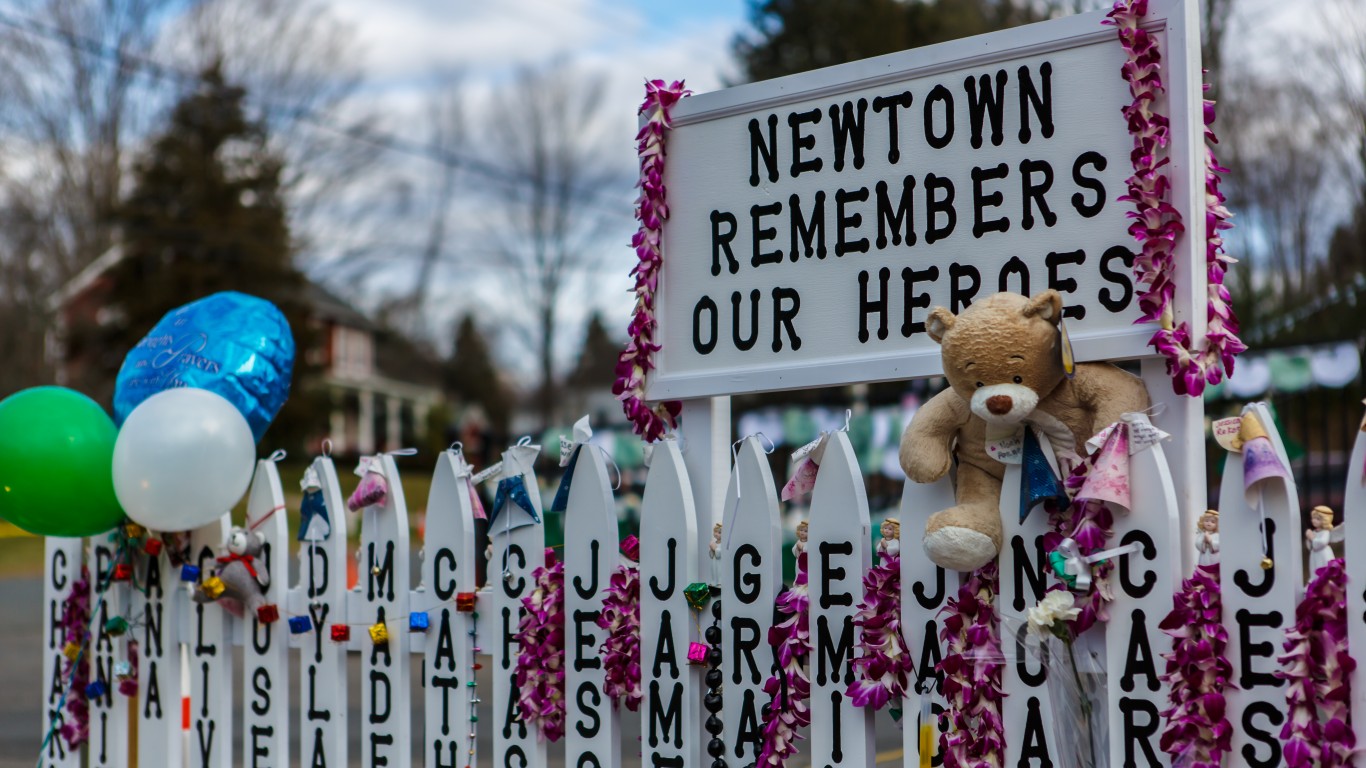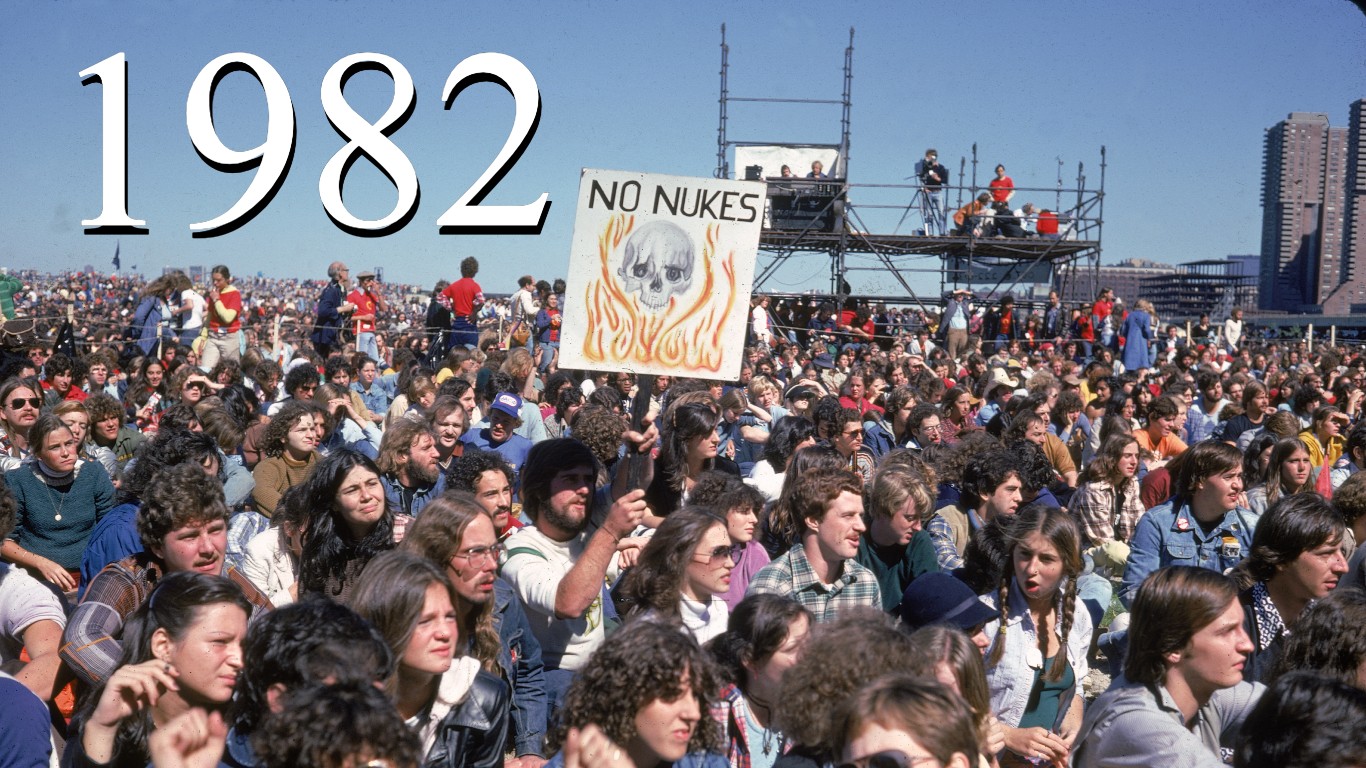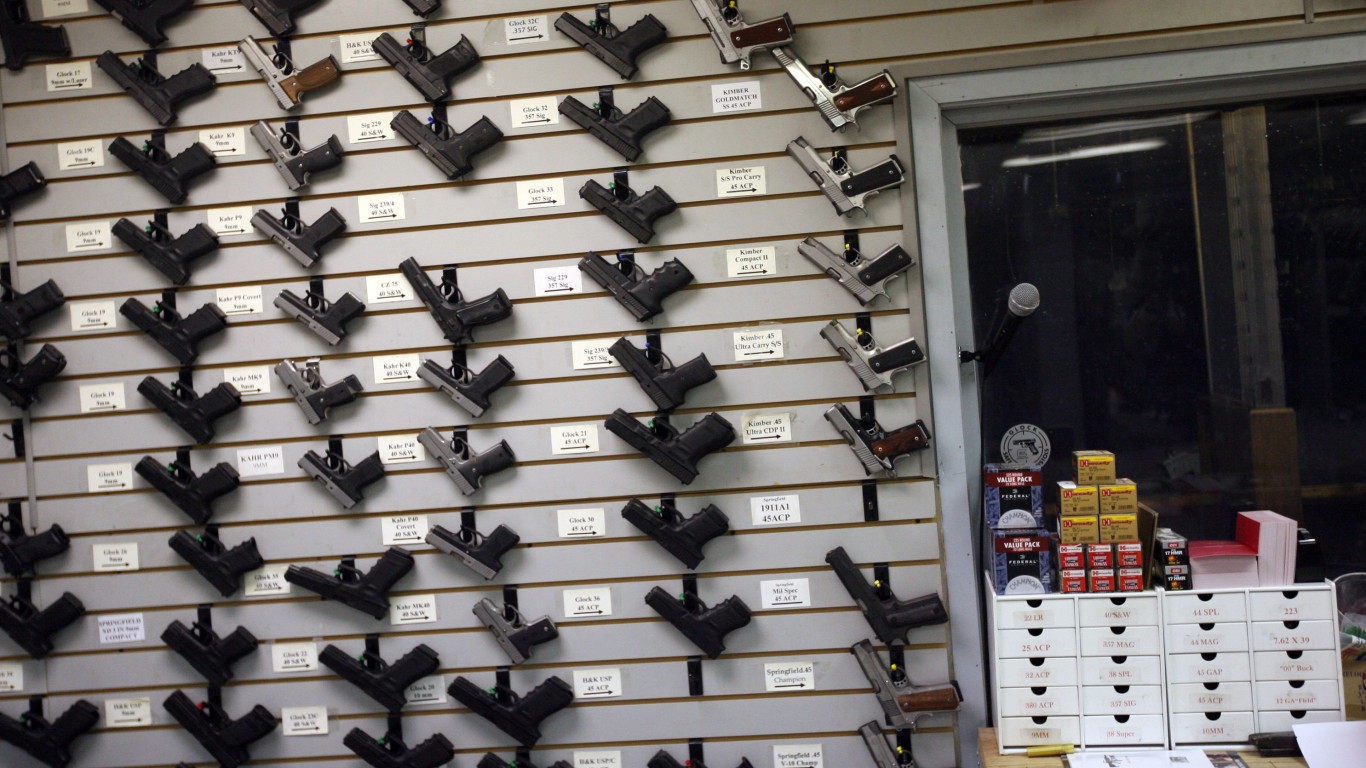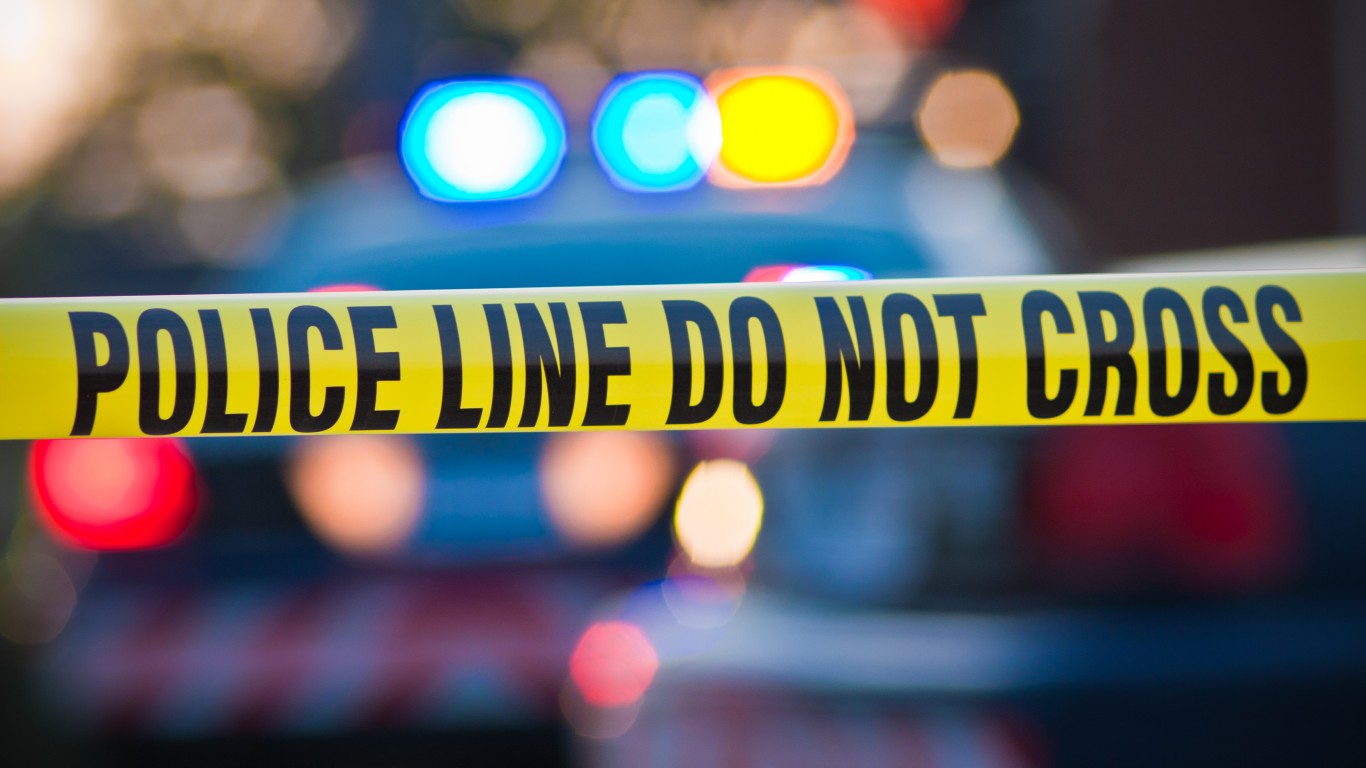
The horrific killing of 19 elementary school students and two teachers in Uvalde, Texas, on May 24, 2022 served as a reminder of how commonplace school shootings have become in recent years in the U.S. In all, there were 302 school shootings last year, far outpacing 2021’s total of 250. That number marks last year as the most violent for school shootings. In reality, gun violence at primary and secondary schools has increased steadily for four decades.
To find the number of school shootings each year since 1982, 24/7 Wall St. reviewed the Center for Homeland Defense and Security’s school shooting database. The Center for Homeland Defense and Security has a broad definition of school shooting, which includes any incident where a firearm is brandished, fired, or a bullet strikes a K-12 school property for any reason at any time of day, regardless of whether there were any victims. It therefore includes gang and domestic violence-related shootings, and shootings occurring at sporting events and after-hours school programs. It includes suicides, fights that turn into shootings, and accidents.
Supplemental data on all mass shootings came from Mother Jones’ Mass Shooting study, which categorizes mass shootings as events where three or more people are killed other than the perpetrator (or where four or more victims are killed prior to 2013). Gun ownership estimates came from historical Gallup polls. (See which Americans own the most guns.)
A notable spike occurred between 2017 and 2018, when school shootings rose from 58 to 119. It was in February 2018 that a gunman opened fire at Florida’s Marjory Stoneman Douglas High School, killing 17 and wounding 17 others.
The list also includes the 1999 massacre at Columbine High School in Littleton, Colorado. Two gunmen took the lives of 13, and left 20 more wounded, in what was then considered the worst school shooting in U.S. history.
Each school shooting prompts calls for stricter gun laws. In June, the $750 million Bipartisan Safer Communities Act was signed into law. Funds will be used by states to bolster school security and provide mental health programs. The act also encourages states to increase background checks for people aged 18 and 21. Meanwhile, gun ownership rates have hovered between 37% and 47% from 1982 until last year. See the states with the loosest gun laws.
Click here to see the number of school shootings every year since 1980.
Click here to read our detailed methodology.

1982
> School shootings: 18
> Mass shootings (4+ victims killed): 1
> U.S. gun ownership: 45% (est.)
[in-text-ad]

1983
> School shootings: 25
> Mass shootings (4+ victims killed): 0
> U.S. gun ownership: 45% (est.)

1984
> School shootings: 25
> Mass shootings (4+ victims killed): 2
> U.S. gun ownership: 45% (est.)

1985
> School shootings: 20
> Mass shootings (4+ victims killed): 0
> U.S. gun ownership: 44%
[in-text-ad-2]

1986
> School shootings: 16
> Mass shootings (4+ victims killed): 1
> U.S. gun ownership: 44% (est.)

1987
> School shootings: 25
> Mass shootings (4+ victims killed): 1
> U.S. gun ownership: 44% (est.)
[in-text-ad]

1988
> School shootings: 38
> Mass shootings (4+ victims killed): 1
> U.S. gun ownership: 44% (est.)

1989
> School shootings: 19
> Mass shootings (4+ victims killed): 2
> U.S. gun ownership: 44% (est.)

1990
> School shootings: 18
> Mass shootings (4+ victims killed): 1
> U.S. gun ownership: 47%
[in-text-ad-2]

1991
> School shootings: 32
> Mass shootings (4+ victims killed): 3
> U.S. gun ownership: 47% (est.)

1992
> School shootings: 33
> Mass shootings (4+ victims killed): 2
> U.S. gun ownership: 47% (est.)
[in-text-ad]

1993
> School shootings: 47
> Mass shootings (4+ victims killed): 4
> U.S. gun ownership: 47% (est.)

1994
> School shootings: 40
> Mass shootings (4+ victims killed): 1
> U.S. gun ownership: 47% (est.)

1995
> School shootings: 22
> Mass shootings (4+ victims killed): 1
> U.S. gun ownership: 47% (est.)
[in-text-ad-2]

1996
> School shootings: 21
> Mass shootings (4+ victims killed): 1
> U.S. gun ownership: 44%

1997
> School shootings: 26
> Mass shootings (4+ victims killed): 2
> U.S. gun ownership: 44% (est.)
[in-text-ad]

1998
> School shootings: 29
> Mass shootings (4+ victims killed): 3
> U.S. gun ownership: 44% (est.)

1999
> School shootings: 22
> Mass shootings (4+ victims killed): 5
> U.S. gun ownership: 44% (est.)

2000
> School shootings: 29
> Mass shootings (4+ victims killed): 1
> U.S. gun ownership: 39%
[in-text-ad-2]

2001
> School shootings: 25
> Mass shootings (4+ victims killed): 1
> U.S. gun ownership: 40%

2002
> School shootings: 19
> Mass shootings (4+ victims killed): 0
> U.S. gun ownership: 41%
[in-text-ad]

2003
> School shootings: 32
> Mass shootings (4+ victims killed): 1
> U.S. gun ownership: 43%

2004
> School shootings: 35
> Mass shootings (4+ victims killed): 1
> U.S. gun ownership: 38%
2005
> School shootings: 47
> Mass shootings (4+ victims killed): 2
> U.S. gun ownership: 40%
[in-text-ad-2]

2006
> School shootings: 59
> Mass shootings (4+ victims killed): 3
> U.S. gun ownership: 43%

2007
> School shootings: 44
> Mass shootings (4+ victims killed): 4
> U.S. gun ownership: 42%
[in-text-ad]

2008
> School shootings: 35
> Mass shootings (4+ victims killed): 3
> U.S. gun ownership: 42%

2009
> School shootings: 31
> Mass shootings (4+ victims killed): 4
> U.S. gun ownership: 40%

2010
> School shootings: 15
> Mass shootings (4+ victims killed): 1
> U.S. gun ownership: 39%
[in-text-ad-2]

2011
> School shootings: 16
> Mass shootings (4+ victims killed): 3
> U.S. gun ownership: 45%

2012
> School shootings: 20
> Mass shootings (4+ victims killed): 7
> U.S. gun ownership: 43%
[in-text-ad]

2013
> School shootings: 34
> Mass shootings (3+ victims killed): 5
> U.S. gun ownership: 37%

2014
> School shootings: 46
> Mass shootings (3+ victims killed): 4
> U.S. gun ownership: 42%

2015
> School shootings: 40
> Mass shootings (3+ victims killed): 7
> U.S. gun ownership: 41%
[in-text-ad-2]

2016
> School shootings: 50
> Mass shootings (3+ victims killed): 6
> U.S. gun ownership: 39%

2017
> School shootings: 58
> Mass shootings (3+ victims killed): 11
> U.S. gun ownership: 42%
[in-text-ad]

2018
> School shootings: 119
> Mass shootings (3+ victims killed): 12
> U.S. gun ownership: 43%

2019
> School shootings: 119
> Mass shootings (3+ victims killed): 10
> U.S. gun ownership: 37%

2020
> School shootings: 114
> Mass shootings (3+ victims killed): 2
> U.S. gun ownership: 42%
[in-text-ad-2]

2021
> School shootings: 250
> Mass shootings (3+ victims killed): 6
> U.S. gun ownership: 42%

2022
> School shootings: 302
> Mass shootings (3+ victims killed): 12
> U.S. gun ownership: 45%
Methodology
To find the number of school shootings each year since 1982, 24/7 Wall St. reviewed the Center for Homeland Defense and Security’s school shooting database. School shooting incidents include any incident where a firearm is brandished or fired at a K-12 school property for any reason at any time of day, regardless of whether there were any shooting victims.
Supplemental data on all mass shootings came from Mother Jones’ Mass Shooting study, which categorizes mass shootings as events where three or more people are killed other than the perpetrator (or where four or more victims are killed prior to 2013). Gun ownership estimates came from historical Gallup polls, representing the percentages of respondents who said yes to the question: “Do you have a gun in your home?” Prior to the year 2000, were not conducted every year. In the cases where Gallup gun ownership data was not available for a particular year, the most recent poll results were used. Some years have multiple gallup polls, and in those cases the latest poll for that year was used.
Get Ready To Retire (Sponsored)
Start by taking a quick retirement quiz from SmartAsset that will match you with up to 3 financial advisors that serve your area and beyond in 5 minutes, or less.
Each advisor has been vetted by SmartAsset and is held to a fiduciary standard to act in your best interests.
Here’s how it works:
1. Answer SmartAsset advisor match quiz
2. Review your pre-screened matches at your leisure. Check out the advisors’ profiles.
3. Speak with advisors at no cost to you. Have an introductory call on the phone or introduction in person and choose whom to work with in the future
Thank you for reading! Have some feedback for us?
Contact the 24/7 Wall St. editorial team.
 24/7 Wall St.
24/7 Wall St. 24/7 Wall St.
24/7 Wall St.



